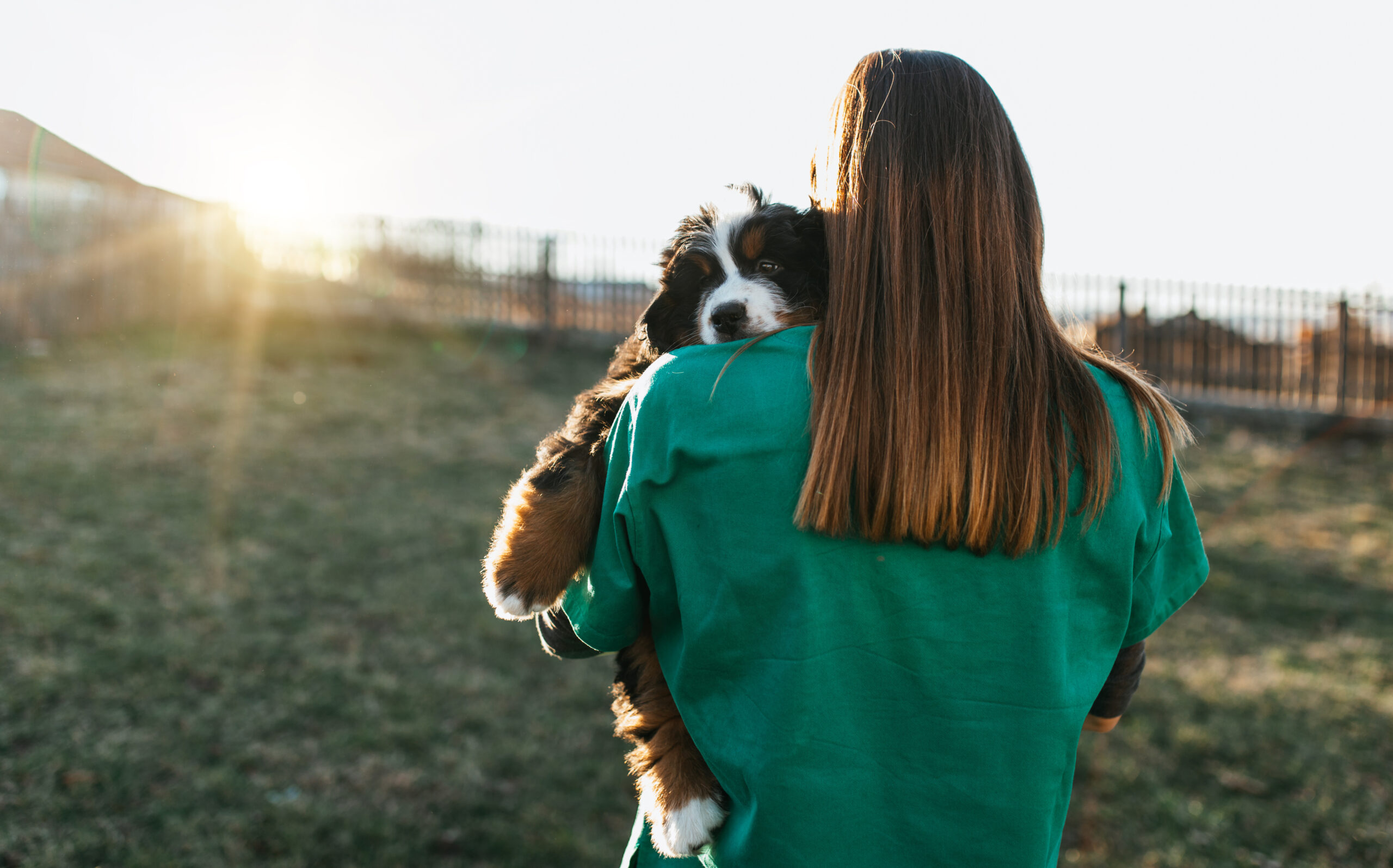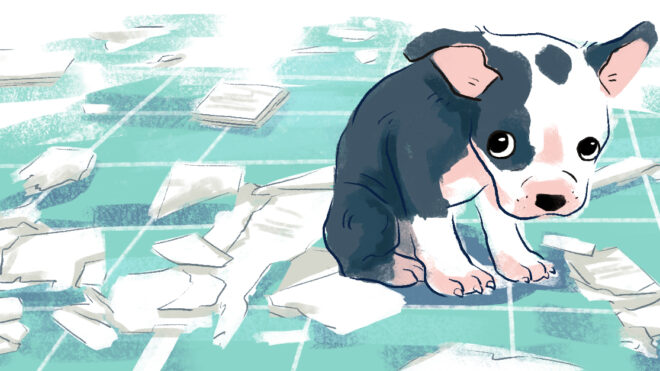
Our dogs can’t tell us when they don’t feel well, so it’s important to be familiar with the most common puppy illnesses. Jennifer Bruns, DVM, MPVM at PetSmart Veterinary Services, tells LittleThings, “The most common puppy illnesses include parvo, kennel cough, and external parasites, such as fleas, roundworm, and hook- and whipworms. While all contagious illnesses pose a threat, parvo and distemper tend to be the ones that give us concern, as the puppies become very sick, and [the diseases] can cause death.”
Erin Katribe, DVM and medical director at Best Friends Animal Society, a leading animal welfare organization working to end the killing of cats and dogs in America’s shelters by 2025, also notes, “Vaccination is available for many serious diseases, but puppies are not reliably protected until they are older than 4 months of age, regardless of previous vaccines. Reducing potential exposure until we know vaccines are effective is our primary strategy to prevent disease, while also understanding that there is a crucial socialization window that we must take advantage of to prevent behavior challenges down the road.”
Experts say at 7 or 8 weeks old, puppies can begin socialization classes, but Bruns warns, “Puppies often become sick by interacting with infected dogs, or coming in contact with contaminated surfaces. Because of this, it’s important to not let your puppy interact with unvaccinated dogs or be in unknown public places until they are fully vaccinated. The vaccination schedule is important — the reason why we vaccinate on a schedule is an important medical concept that works with the puppy’s immune system. Following that schedule and your vet’s recommendation of timing is key to building good immunity.”
Just like human viruses, puppy viruses can remain viable for a while, according to Katribe. “Transmission of disease is variable depending on the disease. For some diseases, there must be direct exposure to another sick dog. For other diseases, like parvo, the virus or pathogen can remain viable for a very long time in the environment, including soil, and so exposure can happen just by a puppy going outside into a contaminated yard. Parvo can remain viable for months in the right conditions.”
Amy Lloyd, VMD, area medical director, Pennsylvania IndeVets, notes, “Puppies become exposed to some of these diseases by interacting with other dogs, sharing bowls and common areas, and coming into contact with nasal secretions, but others can be contracted by simply walking through an area where a sick dog or wild animal may have urinated or defecated.”
One thing you can do to help ensure you have a healthy puppy is to look for signs before you choose a pup. Lloyd says, “In general, a bright inquisitive attitude, good energy level, and good muscle mass are great signs of a healthy puppy. Clear eyes, no nasal discharge or cough, a clean and healthy coat, a good appetite, and healthy stool are also excellent indicators of good health.”
You can also look for signs of good breeding. Lloyd says, “Signs of good breeding are very specific to each individual breed, but in toy breed dogs, you should always check to make sure they don’t have an open fontanelle — a "soft spot" — on their head, and I would also recommend carefully watching a puppy walk to make sure that he/she is comfortable and uses all four limbs evenly. It is also a good idea to check for an umbilical hernia, and if the puppy is male, to take note of whether or not you can see or feel both testicles. These are, of course, all things your vet will check at the first visit, but they are things that you may be able to notice on your own, and that the seller of the puppy should know about and discuss with you.”
Lloyd says, “Some infectious diseases can be incubating at the time you adopt or purchase a puppy, and that puppy may look perfectly normal when you take him or her home, but may get sick within the first two weeks of purchase. It is important to make sure you are aware of any health guarantee offered by a breeder and/or your state’s puppy lemon law if there is one. It is also an excellent idea to get pet insurance two weeks before your first veterinary visit in case something is found at that first visit.”
Jennifer Bruns, DVM, breaks down the most common puppy illnesses:
Parvovirus (Parvo)
What age range does parvovirus impact? “Parvovirus can impact puppies between 12 weeks up to 3 years, but it’s most common in puppies under 6 months old.”
Signs of parvovirus: “The infection often starts with a fever, at which point the pup is highly contagious to other dogs. After a few days they may begin to experience vomiting, diarrhea, dehydration, and weakness.”
Is parvovirus contagious to other dogs in your home? “Parvovirus is highly contagious and is transmitted through bodily secretions and unvaccinated dogs. It can spread through contact with an infected dog or indirect contact with a contaminated object, such as a leash or toy.”
How is parvovirus treated? “Hospitalization is the best route for treating parvo. Your puppy will be given IV fluids and, if needed, antibiotics to prevent sepsis. The recovery time is around three to seven days, and puppies are usually hospitalized for three to four days. When your puppy begins exhibiting symptoms, it’s important to bring them to the vet as soon as possible.”
Distemper
What age range does distemper impact? “Unvaccinated dogs and puppies up to 6 months old are most commonly infected with distemper. However, dogs of all ages can be infected if they are exposed and not protected by vaccination.”
Signs of distemper: “Distemper usually appears as an upper respiratory disease with sneezing and eye discharge. It can develop into pneumonia or lead to neurological problems.”
Is distemper contagious to other dogs in your home? “Distemper is contagious for unvaccinated dogs. Your puppy’s first distemper vaccination typically takes place at 6 to 8 weeks and with a booster after 9 weeks. Once both doses have been administered, your puppy will develop a strong immunity to the disease.”
How is distemper treated? “Medical attention is needed for treatment and usually involves inpatient supportive care with a multiple week recovery period.”
Important to know: “Distemper can lie dormant in previously infected dogs and break out again in the future.”
Giardia
What age range does giardia impact? “All dogs can contract giardia, but most will be asymptomatic carriers without developing signs of illness. However, younger puppies are more likely to exhibit clinical signs.”
Signs of giardia: “Giardia leads to weight loss, diarrhea, and fatty stool. Diarrhea may be intermittent, and your puppy may become less active as well.”
Is giardia contagious to other dogs in your home? “Giardia is contagious to other dogs as well as humans. If your dog has giardia, avoid public spaces, clean contaminated areas, and keep them away from other animals.”
How is giardia treated? “Your veterinarian will determine what course of treatment is best for your dog, as it depends on the severity.”
How do puppies get giardia? “Dogs contract giardia when they swallow the cyst stage of the parasite, and it can be transmitted by eating or sniffing the cysts from contaminated ground or drinking contaminated water. It can also be transmitted by rodents and other wildlife in our backyards, but urban dogs can also be exposed.”
Kennel Cough
What age range does kennel cough impact? “Any dog can get kennel cough, but unvaccinated or immunocompromised dogs as well as young puppies are most at risk.”
Signs of kennel cough: “Kennel cough first presents with lethargy, decreased appetite, and fever and then develops into a deep, productive cough.”
Is kennel cough contagious to other dogs in your home? “Kennel cough is highly contagious, but puppies can be vaccinated starting at 6 to 8 weeks and then every 6 to 12 months after that. The vaccine doesn’t protect against the disease, but it can lead to milder symptoms.”
How is kennel cough treated? “If your puppy is showing any unusual coughing, take them to vet immediately to ensure the cough is not developing into pneumonia. Kennel cough typically runs its course in 10 to 14 days.”
How do puppies get kennel cough? “This disease is spread through airborne droplets, direct contact, or contaminated surfaces.”
Canine Influenza (Dog Flu)
What age range does canine flu impact? “All dogs can get canine flu, and it typically spreads among dogs housed in kennels and shelters.”
Signs of canine flu: “Signs of dog flu include cough, runny nose, fever, lethargy, eye discharge, and reduced appetite.”
Is canine flu contagious to other dogs in your home? “Canine flu is contagious. If a dog is showing signs of a respiratory disease, keep them away from other pets, and disinfect all surfaces after exposure.”
How is canine flu treated? “Most dogs recover within two to three weeks. If your dog is showing signs of canine influenza, make sure to bring them to their vet to ensure it doesn’t develop into a more severe illness and pneumonia.”
How do puppies get canine flu? “It’s spread through respiratory droplets produced during coughing and sneezing from infected dogs, or through contact with contaminated surfaces.”
Leptospirosis
What age range does leptospirosis impact? “Any dogs can get leptospirosis, but it most severely affects young puppies.”
Signs of leptospirosis: “The symptoms are very vague, but they typically include vomiting, fever, and/or lethargy. It’s very dangerous and leads to kidney failure. It’s also a zoonotic disease, so people can get it from their pet.”
Is leptospirosis contagious to other dogs in your home? “It is contagious, but dogs can be vaccinated against leptospirosis at 10 to 12 weeks and again at 13 to 15 weeks.”
How is leptospirosis treated? “Leptospirosis requires very intensive treatment, as it involves kidney failure, which requires fluids and hospitalization. This is a very important vaccine for your dog to get. Oftentimes, breeders will tell owners not to vaccinate, but this is untrue.”
How do puppies get leptospirosis? “Leptospirosis is transmitted through contaminated water and infected urine. It is also carried by wildlife and farm animals.”
Vomiting (and Diarrhea)
“There can be a number of causes, ranging from infection, eating something that causes a blockage, change in food, etc. Continue to offer water and provide food if they’re willing to eat, but the most important thing is to keep them hydrated. If they’ve had over 12 hours of vomiting or 24 hours of diarrhea, take them to your veterinarian to rule out intestinal parasites or any other diseases. However, if it is a small dog with active vomiting and/or diarrhea, bring them to the vet after a few hours.”







